HOME
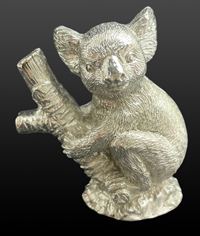
KOALA
Phascolarctos cinereus
| Phascolarctos, is derived from Greek phaskolos "pouch" and arktos "bear". Its species name, cinereus, is Latin and means "ash-coloured". The koala is a marsupial (a group of
animals which carry their young in a pouch) and not a bear as is commonly depicted. The Koala lives it's life in the branches of eucalyptus trees. They live on a diet of
eucalyptus leaves, eating about 500 grams a day. It gains fluid from the leaves and never needs to drink. Koalas are most active at night. Like it's closest relative, the wombat, the koala has a backward-opening pouch. Females give birth to extremely underdeveloped young, which must complete their development in the pouch |
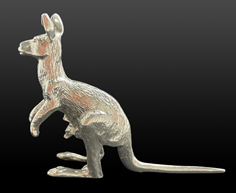
KANGAROO
Macropus rufusThe kangaroo, a symbol of Australia, is a
marsupial from the family Macropodidae
(macropods, meaning 'large foot').
The kangaroo is probably the world's best known marsupial (a group of animals that carry their young in a pouch).The kangaroo is the animal symbol of Australia. Kangaroos can travel at up to 40 mph (70 km/h) by
taking leaps of up to 30 feet (9 metres) in a single hop.
They feed on grass, leaves and roots. They swallow their food and later regurgitate a cud and chew it. |
WHOLESALE ONLYMINIMUM QUANTITIES APPLY
MINIMUM ORDER $300.00 Price Includes Laminated Description Card
and Velveteen Pouch (unless otherwise stated)
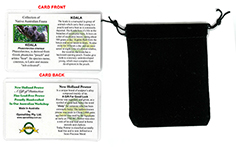
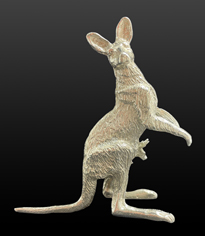
|
AUS 001
Large Kangaroo
Standing
SIZE:
7.3 X 8 X 2cms
WEIGHT:
72 gms
PRICE: $28.00
(Pouch not included)
|
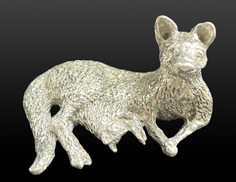 |
AUS002
kangaroo
Laying Down
SIZE:
2.5x3.5x2.1
WEIGHT:
15.7 gms
PRICE: $15.00 |
 |
AUS003
Leaping Kangaroo
SIZE: 6.2x5.2x1.3
WEIGHT:
15.7 gms
PRICE: $15.00 |
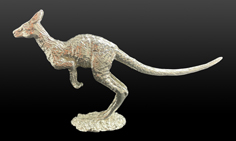 |
AUS004
Large Kangraroo
Leaping
SIZE:
10.5x6x2 cms
WEIGHT:
55 gms
PRICE: $28.00
(Pouch not included)
|
 |
AUS005
Kangaroo
Standing
SIZE:
6x6x1.5 cms
WEIGHT:
27 gms
PRICE: $22.00 |
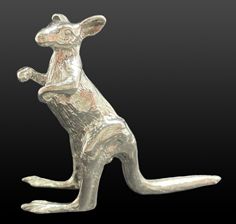 |
AUS005
Kangaroo
Standing
SIZE:
4.2x3.8x1.3 cms
WEIGHT:
12 gms
PRICE: $15.00 |

|
AUS007
Kangaroo
on Base
SIZE:
3.8x3x3.5cms
WEIGHT:
53.5 gms
PRICE: $20.00 |
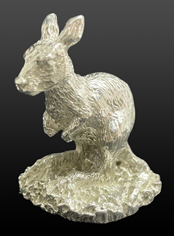 |
AUS008
Kangaroo
on Base
SIZE:
3.8x3x3.5 cms
WEIGHT:
38 gms
PRICE: $18.00 |
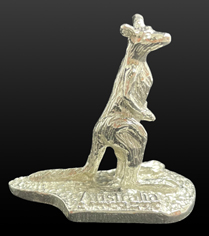 |
AUS009
Small Kangaroo
AUSTRALIA
SIZE:
1.8X3.8X3.6 cms
WEIGHT:
18 gms
PRICE: $12.00 |
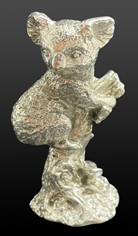 |
AUS010
Koala
on Tree
SIZE:
3.2x5.7x2.5 cms
WEIGHT:
59 gms
PRICE: $25.00 |
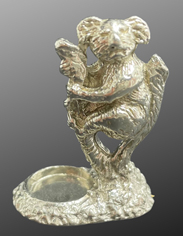 |
AUS011
Small Koala
on Tree
With Cup
SIZE:
2.8x3.3x1.6 cms
WEIGHT:
10.6 gms
PRICE: $15.00 |
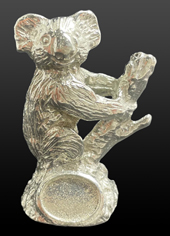 |
AUS012
Koala
on Tree
with 10 x 8 mm cup
SIZE:
2.5x3.6x2 cms
WEIGHT:
21 gms
PRICE: $15.00 |
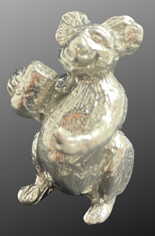 |
AUS013
Kooola Boozer
SIZE:
2x3x1.4 cms
WEIGHT:
23 gms
PRICE: $15.00 |
 |
AUS014
Large Koala
Eating>
SIZE:
3.5x4.3x2.4 cms
WEIGHT:
72 gms
PRICE: $25.00 |
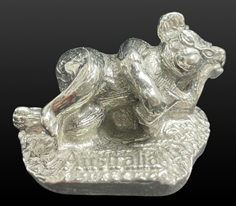 |
AUS015
Koala Lazing
with Beer
SIZE:
3.5x2.7x2 cms
WEIGHT:
33 gms
PRICE: $15.00 |
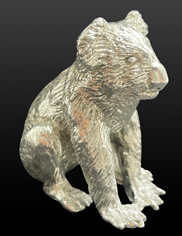 |
AUS016
Large Koala
Sitting>
SIZE:
3.3x4x2.3 cms
WEIGHT:
67 gms
PRICE: $25.00 |
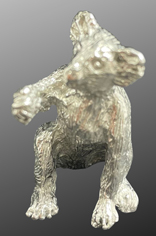 |
AUS017
Small Koala
Eating
SIZE:
3x2x1.7 cms
WEIGHT:
18 gms
PRICE: $15.00 |
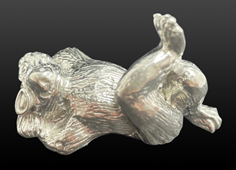 |
AUS018
Koala
Lazing
SIZE:
3.4x2x2.2 cms
WEIGHT:
21 gms
PRICE: $15.00 |
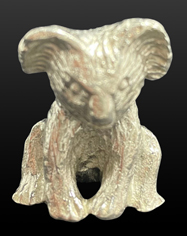 |
AUS019
Small Koala
Sitting
SIZE:
2x2.4x1.5 cms
WEIGHT:
15 gms
PRICE: $12.00 |
 |
AUS020
Koala
on Tree
SIZE:
2.5x3x1.2 cms
WEIGHT:
16 gms
PRICE: $12.00 |
 |
AUS021
Large Koala
Walking
SIZE:
4.7x4.4x2.3 cms
WEIGHT:
65 gms
PRICE: $28.00 |
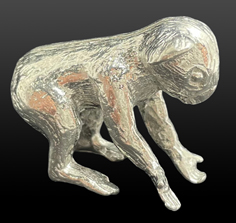 |
AUS022
Bonanza
Miner kneeling
with Pan
and GOLD
SIZE:
3.25x3
x1.5 cms
WEIGHT:
14.3 gms
PRICE: $15.00 |
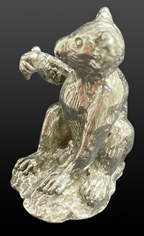 |
AUS023
Koala
on Base
Eating
SIZE:
2.6x3x1.8 cms
WEIGHT:
28 gms
PRICE: $15.00 |
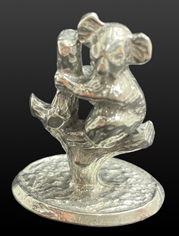 |
AUS024
Small Koala
on Tree
on Base
SIZE:
2.5x3.2x1.8 cms
WEIGHT:
13 gms
PRICE: $12.00 |
 |
AUS025
Koala
on Tree
SIZE:
4x4.4x2.1 cms
WEIGHT:
73 gms
PRICE: $25.00 |
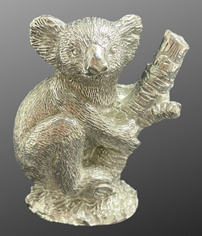 |
AUS026
Koala
On Tree
SIZE:
4.2x4.4x2.1 cms
WEIGHT:
79 gms
PRICE: $25.00 |
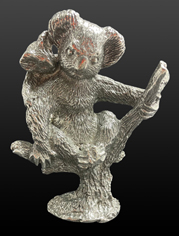 |
AUS027
Large Koala
With Baby
on Tree
SIZE:
6.5x8.3x3.2 cms
WEIGHT:
192 gms
PRICE: $55.00 |
 |
AUS028
Koala
on Tree
SIZE:
3x3.7x2
x1.5 cms
WEIGHT:
35 gms
PRICE: $20.00 |
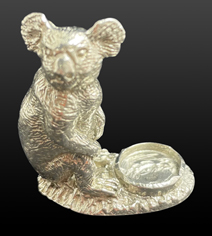 |
AUS029
Koala
Sitting
with Cup
for Gem
SIZE:
3.2x3.4x1.6 cms
WEIGHT:
28 gms
PRICE: $15.00 |
 |
AUS026
Small Koala
On Tree
With base
SIZE:
2.5x3.2x1.8 cms
WEIGHT:
13 gms
PRICE: $12.00 |
Adelie Penguin
Pygoscelis adeliae
Adelie penguins are the dominant penguin species at Cape Denison where Mawson's Huts stand.
The Adélie Penguin is a flightless bird living on the Antarctic ice.
It breeds between October and February laying 2 eggs on a rough nest of stones. The parents take turns of up to 12 shifts incubating the eggs over 32 - 34 days. They feed mainly on varieties of Kryll and Squid. They can swim at up to 70 Km/Hr. Like all penguins, they are highly social, nesting in groups of hundreds of thousands. They are known to migrate up to
17,000 Kms per year.
|
BILBY
Macrotis lagotis
Macrotis lagotis means
"rabbit- eared bandicoot" The bilby is an Australian species of an animal in the Peramelemorphia order. It grows to about 55 cms.
The Bilby is a 'threatened species' They are excellent burrowers and
build extensive tunnel systems. It is widespread in arid, semi-arid and fertile areas, living in spiraling burrows that make it hard for predators to get in.
The male is about the same size as a rabbit. Bilby's have an excellent sense of smell and sharp hearing.
Bilby's are nocturnal omnivores that do not need to drink water as they get all their moisture from their food.
The female has a backward facing pouch which prevents the pouch getting filled with soil whilst burrowing. |
BRUSHTAIL POSSUM
Trichosurus vulpecula
The common brushtail possum, Trichosurus vulpecula, from the Greek for "furry tailed" and the Latin for "little fox", previously in the genus Phalangista) is a nocturnal, semi arboreal arboreal marsupial of the family Phalangeridae, native to Australia and naturalised in New Zealand, and the second-largest of the possums. Like most possums, the common brushtail possum is nocturnal. It is mainly a folivore, but has been known to eat small mammals such as rats. In most Australian habitats, eucalyptus leaves are a significant part of the diet, but rarely the sole item eaten. Its tail is prehensile and naked on its lower underside. It is the Australian marsupial most often seen by city dwellers, as it is one of few that thrive in cities and a wide range of natural and human-modified environments. Around human habitations, common brushtails are inventive and determined foragers with a liking for fruit trees, vegetable gardens, and kitchen raids.
The common brushtail possum has large and pointed ears. Its bushy tail (hence its name) is adapted to grasping branches, prehensile at the end with a hairless ventral patch.
Its fore feet have sharp claws and the first toe of each hind foot is clawless, but has a strong grasp
The possum grooms itself with the third and fourth toes which are fused together.
It has a thick and woolly pelage that varies in colour depending on the subspecies. Colour patterns tend to be silver-grey, brown, black, red, or cream. The ventral areas are typically lighter and the tail is usually brown or black. The muzzle is marked with dark patches.
The common brushtail possum can be found in a variety of habitats, such as forests, semi-arid areas and even cultivated or urban areas. It is mostly a forest inhabiting species, however it is also found in treeless areas.
In Australia, brushtail possums are threatened by humans,
tiger quolls, dogs, foxes, cats, Goannas, carpet snakes
and powerful owls. In New Zealand, brushtail possums are threatened only by humans and cats. The IUCN highlight the population trend in Australia as decreasing.
The common brushtail possum can adapt to numerous kinds of vegetation. It prefers Eucalyptus leaves, but also eats flowers, shoots, fruits, and seeds. It may also consume animal matter such as insects, birds' eggs and chicks, and other small vertebrates. Brushtail possums may eat three or four different plant species during a foraging trip, unlike some other arboreal marsupials, such as the koala and the greater glider, which focus on single species. The brushtail possum's rounded molars cannot cut Eucalyptus leaves as finely as more specialised feeders. They are more adapted to crushing their food, which enables them to chew fruit or herbs more effectively. The brushtail possums' caecum lacks internal ridges and cannot separate coarse and fine particles as efficiently as some other arboreal marsupials. The brushtail possum cannot rely on Eucalyptus alone to provide sufficient protein. It's more generalised and mixed diet, however, does provide adequate nitrogen.
(Ref.: Wikipedia)
|
WATER BUFFALO
Bubalus bubalis
Water buffalo were imported to
Australia in the 19th century to supply meat to remote
northern settlements.
The settlements and their buffalo were abandoned in 1949 and, despite harvesting for meat, hides and as hunters' trophies, feral buffalo spread across the northern
floodplains. The Brucellosis and Tuberculosis Eradication Campaign reduced feral buffalo numbers
significantly in the 1980's and 1990's but numbers are again very high right across northern Australia causing significant damage to wetlands. Feral buffalo are large (450-1200 kilogram)herbivores that prefer to live in swamps and floodplains across the wet parts of northern Australia, where they have ready access to food and water. During most of the dry season
males and females live separately.
|
 CANE TOAD CANE TOAD
Rhinella marinaF068
CANE TOAD
SIZE:
37mm X 35mm X 26mm
WEIGHT: 52 Grams
PRICE: $24.00
The cane toad in Australia is regarded as an exemplary case of a "feral species".Native to South and mainland Middle America, cane toads were introduced to Australia from Hawaii in June 1935 by the Bureau of Sugar Experiment Stations, now Sugar Research Australia, in an attempt to control the native grey-backed cane beetle (Dermolepida albohirtum) and French's beetle (Lepidiota frenchi). The spread of cane toads was slow at first, but by 1959, they had colonised most of Queensland's east coast.
They are now found in the Kimberely’s of Western Australia. Currently, most attempts to curtail the invasion of cane toads have been unsuccessful. Many of these strategies involve the physical trapping of toads, but these methods also capture unintended native species. Since the largest selective pressure on cane toads currently is intraspecies competition, these physical removals often only improve the conditions for untrapped toads. Also, since migration is high, any area purged of toads would most likely be reinvaded quickly.
Many new ideas have been proposed to control the cane toad population. Some have suggested introducing a native viral or bacterial pest of the toads, but this has potential to once again invade native species.
Two similar strategies have been proposed, both of which focus on fecundity. One involves the release of sterile males into the population. These males would compete for resources with other males, while themselves not being able to reproduce. A second strategy would be to insert a gene in female toads, which would allow them to only create male offspring. In theory, this would limit the reproductive rates and control the population. Determining the efficacy and dangers of these approaches is difficult, as these methods have never been attempted, especially on a large scale.
On 13 June 2012, news reports cited a new research breakthrough regarding cane toad control. Cane toad tadpoles are attracted to the toxin produced by adults and spawn as they are believed to cannibalise toad spawn as a food source. Researchers used cane toad toxin to successfully lure cane toad tadpoles, implying that in controlled areas, tadpoles could be captured and eradicated.
In semiarid areas where water is scarce, the construction of toad-proof fences around dams can severely affect toad survival rates by denying them access to water.
(Ref.: Wikipedia)
|
 |
F068
CASSOWARY
SIZE:
37mm X 35mm X 26mm
WEIGHT: 52 Grams
PRICE: $15.00 |
CASOWARY
Struthio casuarius
| Typically, all cassowaries are shy birds that are found in the deep forest. They are adept at disappearing long before a human knows they were there.
Cassowaries are shy birds that are found in the deep forest. They are adept at disappearing long before a human knows they were there.
All cassowaries' feathers consist of a shaft and loose barbules. They do not have retrices (tail feathers) or a preen gland. Cassowaries have small wings with five or six large remiges. These are reduced to a stiff, keratinous quills, resembling porcupine quills, with no barbs.
The furcula and corocoid are degenerate, and their palatal bones and spheroid bones touch each other. These, along with their wedge-shaped body, are thought to be adaptations to ward off vines, thorns, and saw-edged leaves, allowing them to run quickly through the rainforest.
Cassowaries have three-toed feet with sharp claws. The second toe, the inner one in the medial position, sports a dagger-like claw that may be 125mm long.
This claw is particularly fearsome, since cassowaries sometimes kick humans and other animals with their powerful legs. Cassowaries can run at up to 50 Km/h through the dense forest and can jump up to 1.5 metres. They are good swimmers, crossing wide rivers and swimming in the sea.
All three species have a keratinous, skin-covered casque on their heads that grows with age. The casque's shape and size, up to 18cm, is species-dependent. C. Cassarius the largest and C. bennetti the smallest (tricorn shape), with C. unappendiculatus having variations in between. Contrary to earlier finding the hollow inside of the casque is spanned with fine fibres that are believed to have an acoustic function.
Several functions for the casque have been proposed. One is that they are a secondary sexual characteristic. Other suggested functions include being used to batter through underbrush, as a weapon in dominance disputes, or for pushing aside leaf litter during foraging. The latter three are disputed by biologist Andrew Mack, whose personal observation suggests that the casque amplifies deep sounds.
Earlier research indicates the birds lower their heads when running "full tilt through the vegetation, brushing saplings aside and occasionally careening into small trees. The casque would help protect the skull from such collisions". Cassowaries eat fallen fruit, and consequently spend much time under trees where seeds the size of golfballs or larger fall from heights up to 30metres; the wedge-shaped casque may protect the head by deflecting falling fruit.
The casques also may play a role in either sound reception or acoustic communication. This is related to a discovery that at least the dwarf cassowary and southern cassowary produce very-low-frequency sounds, which may aid in communication in dense rainforest. The "boom" vocalisation that cassowaries produce is the lowest-frequency bird call known, and is at the lower limit of human hearing. A cooling function for the very similar casques of guineafowl has been proposed.
The average lifespan of wild cassowaries is believed to be about 40 to 50 years.
Cassowaries are adept at disappearing long before a human knows they were there. The southern cassowary of the Far North Queensland rainforests is not well studied, and the northern and dwarf cassowaries even less so. Females are larger and more brightly coloured than the males. Adult southern cassowaries are 1.5 to 1.8 Meteres tall, although some females may reach 2 Metres and weigh 58.5 Kilograms. Ω
|
| DIDGERIDOO
Aboriginal Australians are the various
Indigenous peoples of the Australian mainland who arrived thousands of years ago.
The Didgeridoo, also spelt didjeridu, is a wind instrument played with continuous
vibrating lips to produce a continuous tone while using a continuous breathingtechnique called circular breathing. The didgeridoo was developed by north eastern Indigenous
Australians about 1,500 years ago. It is usually made from hollow hardwood tree trunks. Once a suitably hollow tree is found, it is cut down and cleaned out, the bark is taken off, the ends trimmed, and the exterior is shaped; this results in a finished instrument.
|
EMPEROR PENGUIN
Aptenodytes forsteri
The Emperor Penguin lives in large colonies on the Antartic ice.
Penguins employ physiological
adaptations and cooperative behaviors in order to deal with the harsh
environment, where wind chills can reach -60ºC. They huddle together conserve warmth and take turns
moving to the interior of the group. Once warmed, they move to the
outside. They feed on fish, Kryll and squid diving to over 500 metres and stay under for 20 minutes or more.
|
FAIRY PENGUIN
Eudyptula minor
| The Little Penguin, also known as 'Fairy Penguin' in Australia, is the smallest of all penguins.
only 40cm in length. Penguins are only found in the Southen Hemisphere. They spend most of their day at sea catching fish and return to their burrows late at night. The 'Fairy Penguin' is
common to Southern Australia and has been made famous by the
'Penguin Parade' and Phillip Island, Victoria. The Little Penguin was first described by German naturalist Johann Reinhold Forster in 1781.
Several subspecies are also known. |
FRESHWATER CROCODILE
Crocodylus johnstoni
| The Freshwater Crocodile, or the 'freshie' as it is
colloquially known, is endemic to the northern regions of
Australia. They are not known as maneaters. Gerard Krefft named the species in 1873 after a man named Johnston first
reported the species. The freshwater crocodile or 'Johnston River Crocodile' is found in Western Australia, Northern Territory and Queensland. The freshie' inhabits freshwater wetlands, billabongs, rivers and creeks. Adults eat birds, bats, reptiles, amphibians and fish but larger adults may take prey as large as wallabies. It's population has declined in recent years due to the ingestion
of the invasive Cane Toad. |
PLATYPUS
Ornithorhynchus anatinus
| The Platypus, a semi-aquatic animal, is one of five species of monotremes, mammals that lay eggs. The platypus, also known as
'the duck-bill platypus' is an unusual animal and early European naturalists thought it was an eloborate fraud. It was said to be an animal designed and put
together by a group of scientists. It has a duck-bill, beaver-tail, otter-foot and a venomous spur on it’s hind foot. The male grows to a length of 50 cms.
They inhabit the eastern parts of
Australia living in borrows about 30 cms above the creek. They dig in the creek bed with their snout for food. Their diet consists of freshwater shrimps, yabbies, molluscs and insect larvae.
|
SALTWATER CROCODILE
Crocodylus porosus
The Saltwater or Estuarine Crocodile is the largest of all
living reptiles. The 'Saltie', as it is known locally, inhabits
northern Australia
The Saltwater crocodile evolved over 65 million years ago. They are territorial and opportunistic predators growing to 5.5 metres in length and weighing over a tonne. The larger males dominate their territory where the best food is available. Young crocodiles feed on fish, insects and crustaceans. Adults feed on anything,
including humans, that comes to the water's edge. They either actively hunt or sit and wait for passing prey, staying
submerged for 2 hours or more.
Being cold blooded they regulate their
temperature by lying in the sun and move to the shade to cool down. |
THORNY DEVIL
Moloch horridus
|
The Thorny Devil is a native Australian lizard. It is also known as the Thorny Dragon, Mountain Devil, Thorny
Lizard or Moloch. Thorny Devils grow to a length of
20 Cms and can live for 20 years. Their camouflage colour can change from dark to light in warmer climates. They are covered entirely in mostly uncalcified conical poisonous spikes which also features a 'false head' on the back of the neck. These spines act as a defense mechanism against predators. The Thorny Devil’s body is ridged in structure, and enables the animal to collect water,
condensed from overnight dew, from any part of the body, which is then
channelled to the mouth. They feed on many species of ants. |
COMMON WOMBAT
Vombatus ursinus
| The common wombat or bare nosed wombat is a stocky,
shortlegged Marsupial native to Australia. It is a herbivore found mainly in coastal areas of South East Australia. When fully grown they can reach anywhere between 80 - 130 Cms in length and weigh up to 40Kgs. Common wombats are solitary and territorial with each wombat having an established area where they live and feed. In this area they dig a tunnel system up to 20 metres long with many side tunnels. Wombats have a backward opening pouch which prevents the pouch being filled when digging. The gestation period is about 20 - 30 days. |
FRILL NECK LIZARD
Chlamydosaurus kingi
The frill-necked lizard is so called because of the large ruff of skin around it's neck which it raises to discourage predators.Also known as frilled lizard or frilled dragon, the Frill necked lizard is found mainly in northern Australia. It is aboreal, spending most of the day in trees. It is a relatively large lizard growing to a length of 91 Cms. It's frill usually stays folded beside it's body. The frill is is supported by long spines of cartilage which are connected to the jaw bone. When the lizard is frightened it gapes it's mouth
exposing a bright pink and yellow lining. The frills flare out displaying bright orange and red scales. The lizard survives on a diet of
insects and small vertebrates.
|
PEWTER FIGURINES CONTINUED
PEWTER FIGURINES
Made in Australia by
Gemstones of Australia Pty. Ltd.
Learn How
They Are Made
WHOLESALE PRICES ONLY -
DISTRIBUTOR ENQUIRIES, PLEASE WRITE
New
Holland Pewter
New Holland Pewter is our
unique brand of fine lead-free pewter which has been made in
Australia since 1983. The original master pattern is
designed in our studio, then hand crafted to create the three
dimensional model. There are several ways to create the master
pattern but usually the 'lost wax' method is preferred. From
the wax pattern a bronze or silver master pattern is made.The
master pattern is then used to make what we call a 'master mould'
from which a quantity of originals are reproduced. These are
second generation masters and each one is carefully hand detailed
in order to make a production mould for centrifugal casting.
After casting each piece is individually handcrafted to remove
any imperfections and is then polished to a high glossy finish
using polishing techniques developed by us over a quarter of
a century.
For generations, pewter
has been a highly regarded metal, fourth in line as the most
used metal in the jewellery industry after gold, silver and platinum.
Pewter could, in fact, be called, the Semi-Precious Metal
because
it is the metallic equivalent of semi-precious stones and is
the metal of choice for sculptors in the jewellery, gift and
souvenir industries.
Each piece is hand crafted
to perfection in our studio and, when polished to perfection,
looks like sterling silver.
To meet the international
standard for this beautiful metal, pewter is classified as being
lead-free.
The New Holland brand of
pewter will not tarnish under normal conditions and, because
it is lead-free, is completely non-toxic. When you look for pewter
figurines, always look for our brand, New Holland Pewter.
We offer a service in custom
making original patterns and mould making. We can custom make
to your own design, make the mould and cast and finish each piece
to perfection.
Our custom made pewter
figurines are only made in the finest
lead-free pewter . Our
fine pewter is unique and, when polished, looks like sterling
silver. |
Australian Fauna Pewter Figurines

|
Mineral
Box - Suitable
for micromounts, thumbnails and miniatures.
Have you seen our fine quality
LEAD FREE
Pewter Mining Figurines
HOME
| |